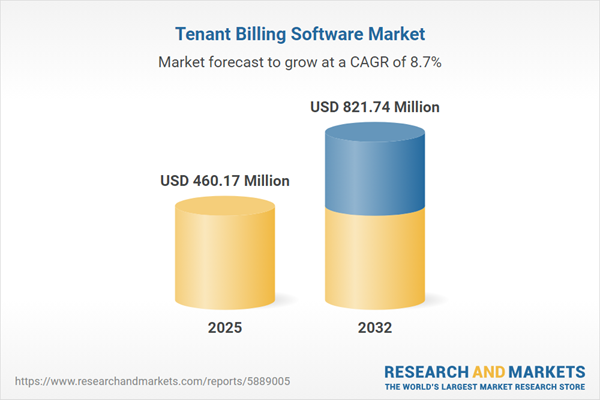Speak directly to the analyst to clarify any post sales queries you may have.
The tenant billing software market is advancing rapidly, driven by evolving property management requirements and increased focus on financial transparency. Senior decision-makers are prioritizing solutions that support operational efficiency, compliance, and a seamless tenant experience across various property types and business models.
Market Snapshot: Growth Trajectory for Tenant Billing Software
The tenant billing software market grew from USD 422.75 million in 2024 to USD 460.17 million in 2025. It is projected to maintain robust momentum at a CAGR of 8.66%, reaching USD 821.74 million by 2032. This expansion is linked to greater adoption of automated, cloud-based platforms and the pressing need for integrated financial processes within property management organizations.
Scope & Segmentation of Tenant Billing Software Market
- Deployment Models: Cloud (Private Cloud, Public Cloud), On Premise (Data Center Hosted, Self Hosted)
- Industry Verticals: Healthcare (Clinics, Hospitals), Hospitality (Hotels, Resorts), Property Management (Commercial, Residential), Retail (Brick and Mortar, E-Commerce)
- Solution Types: Integrated Accounting and Billing (With or Without Inventory Management), Subscription Management (Recurring Billing, Usage-Based Billing)
- Regional Coverage: Americas (North America: United States, Canada, Mexico; Latin America: Brazil, Argentina, Chile, Colombia, Peru), Europe, Middle East & Africa (Europe: United Kingdom, Germany, France, Russia, Italy, Spain, Netherlands, Sweden, Poland, Switzerland; Middle East: United Arab Emirates, Saudi Arabia, Qatar, Turkey, Israel; Africa: South Africa, Nigeria, Egypt, Kenya), Asia-Pacific (China, India, Japan, Australia, South Korea, Indonesia, Thailand, Malaysia, Singapore, Taiwan)
- Leading Vendors: Yardi Systems, Inc.; RealPage, Inc.; AppFolio, Inc.; MRI Software, LLC; Entrata, Inc.; ResMan, LLC; Buildium, LLC; PayLease, LLC; VTS, Inc.; TenantCloud, Inc.
Key Takeaways for Senior Decision-Makers
- Advanced tenant billing software enables replacement of fragmented legacy systems, resulting in unified, automated workflow management for invoicing and payments.
- Integration with broader property management, CRM, and energy management systems is becoming standard, facilitating real-time data sharing and financial analytics.
- Elevated data security, audit trails, and customizable compliance modules address emerging regulatory demands, positioning organizations to meet evolving standards.
- Cloud-based deployments are prioritized for scalability and cost optimization, whereas on-premise solutions remain important in sectors with strict governance mandates.
- Organizations seek vendor partnerships and modular approaches, tailoring functionality to the unique requirements of healthcare, hospitality, commercial, and retail environments.
Tariff Impact on Tenant Billing Software Market
The introduction of tariffs in the United States in 2025 affected costs across technology supply chains, notably for hardware and cloud infrastructure. Software vendors are responding with varied sourcing strategies and revising subscription models to manage increased operational expenses. Users are reassessing contracts to balance pricing, deployment model flexibility, and supply chain resilience.
Tenant Billing Software Market: Methodology & Data Sources
This report applies a structured research methodology combining secondary data review, stakeholder interviews, and data triangulation. Input sources include published financials, regulatory filings, expert interviews, case studies, and regional industry insights. Peer review and stakeholder workshops minimized biases, ensuring balanced, actionable intelligence.
Why This Report Matters for the Tenant Billing Software Market
- Equips executives with clarity on evolving deployment models, compliance strategies, and regional growth opportunities in tenant billing solutions.
- Supports informed investment decisions by providing segmentation analysis and vendor benchmarking tailored for property management, healthcare, hospitality, and retail leaders.
Conclusion
Strategic use of tenant billing software is essential to achieving operational excellence and compliance. Decision-makers equipped with data-driven insights are well-positioned to adapt to market shifts and maximize value through innovative, transparent financial management practices.
Additional Product Information:
- Purchase of this report includes 1 year online access with quarterly updates.
- This report can be updated on request. Please contact our Customer Experience team using the Ask a Question widget on our website.
Table of Contents
3. Executive Summary
4. Market Overview
7. Cumulative Impact of Artificial Intelligence 2025
Companies Mentioned
The companies profiled in this Tenant Billing Software market report include:- Yardi Systems, Inc.
- RealPage, Inc.
- AppFolio, Inc.
- MRI Software, LLC
- Entrata, Inc.
- ResMan, LLC
- Buildium, LLC
- PayLease, LLC
- VTS, Inc.
- TenantCloud, Inc.
Table Information
| Report Attribute | Details |
|---|---|
| No. of Pages | 180 |
| Published | October 2025 |
| Forecast Period | 2025 - 2032 |
| Estimated Market Value ( USD | $ 460.17 Million |
| Forecasted Market Value ( USD | $ 821.74 Million |
| Compound Annual Growth Rate | 8.6% |
| Regions Covered | Global |
| No. of Companies Mentioned | 11 |









